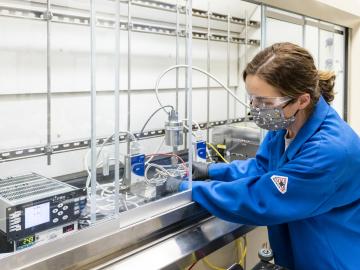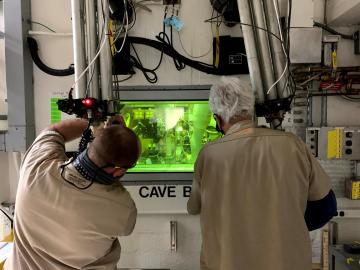
Filter News
Area of Research
- Advanced Manufacturing (2)
- Biology and Environment (49)
- Biology and Soft Matter (1)
- Computational Biology (1)
- Computational Engineering (1)
- Computer Science (5)
- Energy Science (38)
- Fusion and Fission (12)
- Fusion Energy (1)
- Isotopes (23)
- Materials (35)
- Materials for Computing (7)
- National Security (26)
- Neutron Science (17)
- Nuclear Science and Technology (11)
- Quantum information Science (2)
- Supercomputing (99)
News Type
News Topics
- (-) Advanced Reactors (24)
- (-) Artificial Intelligence (112)
- (-) Clean Water (18)
- (-) Computer Science (174)
- (-) Isotopes (53)
- (-) ITER (6)
- 3-D Printing/Advanced Manufacturing (105)
- Big Data (53)
- Bioenergy (93)
- Biology (106)
- Biomedical (59)
- Biotechnology (35)
- Buildings (45)
- Chemical Sciences (70)
- Composites (23)
- Coronavirus (36)
- Critical Materials (16)
- Cybersecurity (31)
- Education (5)
- Element Discovery (1)
- Emergency (3)
- Energy Storage (75)
- Environment (154)
- Exascale Computing (64)
- Fossil Energy (7)
- Frontier (60)
- Fusion (54)
- Grid (48)
- High-Performance Computing (113)
- Hydropower (6)
- Machine Learning (50)
- Materials (111)
- Materials Science (111)
- Mathematics (8)
- Mercury (9)
- Microelectronics (4)
- Microscopy (40)
- Molten Salt (5)
- Nanotechnology (46)
- National Security (78)
- Neutron Science (136)
- Nuclear Energy (94)
- Partnerships (67)
- Physics (60)
- Polymers (22)
- Quantum Computing (48)
- Quantum Science (79)
- Security (28)
- Simulation (52)
- Software (1)
- Space Exploration (16)
- Statistics (3)
- Summit (62)
- Transportation (56)
Media Contacts

For years Brenda Smith found fulfillment working with nuclear batteries, a topic she’s been researching as a chemist at Oak Ridge National Laboratory.

At the Department of Energy’s Oak Ridge National Laboratory, scientists use artificial intelligence, or AI, to accelerate the discovery and development of materials for energy and information technologies.

The Department of Energy’s Oak Ridge National Laboratory has licensed its award-winning artificial intelligence software system, the Multinode Evolutionary Neural Networks for Deep Learning, to General Motors for use in vehicle technology and design.

The U.S. Department of Energy’s Innovative and Novel Computational Impact on Theory and Experiment, or INCITE, program is seeking proposals for high-impact, computationally intensive research campaigns in a broad array of science, engineering and computer science domains.

Using complementary computing calculations and neutron scattering techniques, researchers from the Department of Energy’s Oak Ridge and Lawrence Berkeley national laboratories and the University of California, Berkeley, discovered the existence of an elusive type of spin dynamics in a quantum mechanical system.

The Accelerating Therapeutics for Opportunities in Medicine , or ATOM, consortium today announced the U.S. Department of Energy’s Oak Ridge, Argonne and Brookhaven national laboratories are joining the consortium to further develop ATOM’s artificial intelligence, or AI-driven, drug discovery platform.

A rare isotope in high demand for treating cancer is now more available to pharmaceutical companies developing and testing new drugs.

Oak Ridge National Laboratory was among an international team, led by Lawrence Livermore National Laboratory, who synthesized 108 elevated carbon dioxide, or CO2, experiments performed in various ecosystems to find out how much carbon is

A new method developed at Oak Ridge National Laboratory proves one effort’s trash is another’s valuable isotope. One of the byproducts of the lab’s national plutonium-238 production program is promethium-147, a rare isotope used in nuclear batteries and to measure the thickness of materials.

Researchers at the Department of Energy’s Oak Ridge National Laboratory and the University of Tennessee are automating the search for new materials to advance solar energy technologies.


